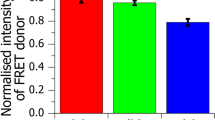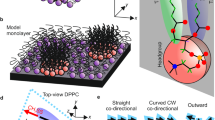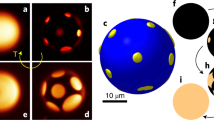Abstract
Phospholipid or fatty acid monolayers at the air–water interface exhibit a series of pressure and temperature-dependent two-dimensional conformational changes1–3. New techniques1–3 of studying the microscopic heterogeneity of lipid monolayers have shown that, with increasing pressure, they undergo first a gas–fluid phase transition via a two-dimensional foam2, and subsequently a transition, extending over a finite pressure region of several mN m−1, from the fluid to a crystalline state. This could be attributed to the coexistence of these states1 and has been explained in terms of their different electric polarizations—a new picture of the fluid–solid phase transition. We have demonstrated4 that monolayers may be transferred from the air–water interface to solid substrates, not only from completely condensed, but also from more expanded, states such as these fluid–solid coexistence regions of pure and mixed monolayers. This suggests new possibilities of preparing Langmuir–Blodgett films with mosaic-like arrangements of crystalline and amorphous patches several micrometres in diameter5. We report here a new electron microscopy technique which allows us to study the microstructure of such films, without any staining, up to a resolution of 1,000 Å. Different phases may be distinguished by phase contrast, owing to differences in electric charging caused by a corresponding difference in the electric conductivities, and electron diffraction patterns taken from selected areas can give information on the molecular packing of the phases.
This is a preview of subscription content, access via your institution
Access options
Subscribe to this journal
Receive 51 print issues and online access
$199.00 per year
only $3.90 per issue
Buy this article
- Purchase on Springer Link
- Instant access to full article PDF
Prices may be subject to local taxes which are calculated during checkout
Similar content being viewed by others
References
Fischer, A., Lösche, M., Möhwald, H. & Sackmann, E. J. Phys. Lett. 45, L785–L791 (1984).
Lösche, M., Sackmann, E. & Möhwald, H. Ber. Bunsenges. phys. Chem. 87, 848–852 (1983).
McConnell, H. M., Tamm, L. K. & Weiss, R. M. Proc. natn Acad. Sci. U.S.A. 81, 3249–3253 (1984).
Fischer, A. & Sackmann, E. J. Phys. 45, 517–527 (1984).
Lösche, M. et al. Thin Solid Films 117, 269–280 (1984).
Roberts, G. G. Springer Ser. Electrophys. 7, 56–62 (1981).
Swalen, J. D., Tacke, M., Santo, R., Riekhoft, K. E. & Fischer, J. Helv. chim. Acta 61, 960–977 (1978).
Kuhn, H. Thin Solid Films 99, 1–16 (1983).
Reimer, L. Springer Ser. opt. Sci. 36, 249–258 (1984).
Engel, A., Baumeister, W. & Saxton, W. O. Proc. natn Acad. Sci. U.S.A. 79, 4050–4054 (1982).
Albrecht, O., Gruler, H. & Sackmann, E. J. Colloid Interface Sci. 79, 319–338 (1981).
Slaytor, E. M. Optical Methods in Biology (Krieger, New York, 1976).
Author information
Authors and Affiliations
Rights and permissions
About this article
Cite this article
Fischer, A., Sackmann, E. A charge-decoration technique for studying the heterogeneity of coexistent monolayer phases by electron microscopy. Nature 313, 299–301 (1985). https://doi.org/10.1038/313299a0
Received:
Accepted:
Issue Date:
DOI: https://doi.org/10.1038/313299a0
This article is cited by
-
Low-flux scanning electron diffraction reveals substructures inside the ordered membrane domain
Scientific Reports (2020)
-
Anomalous spreading behaviour of polyethyleneglycoldistearate monolayers at air/water interface
Journal of Chemical Sciences (2001)
Comments
By submitting a comment you agree to abide by our Terms and Community Guidelines. If you find something abusive or that does not comply with our terms or guidelines please flag it as inappropriate.



